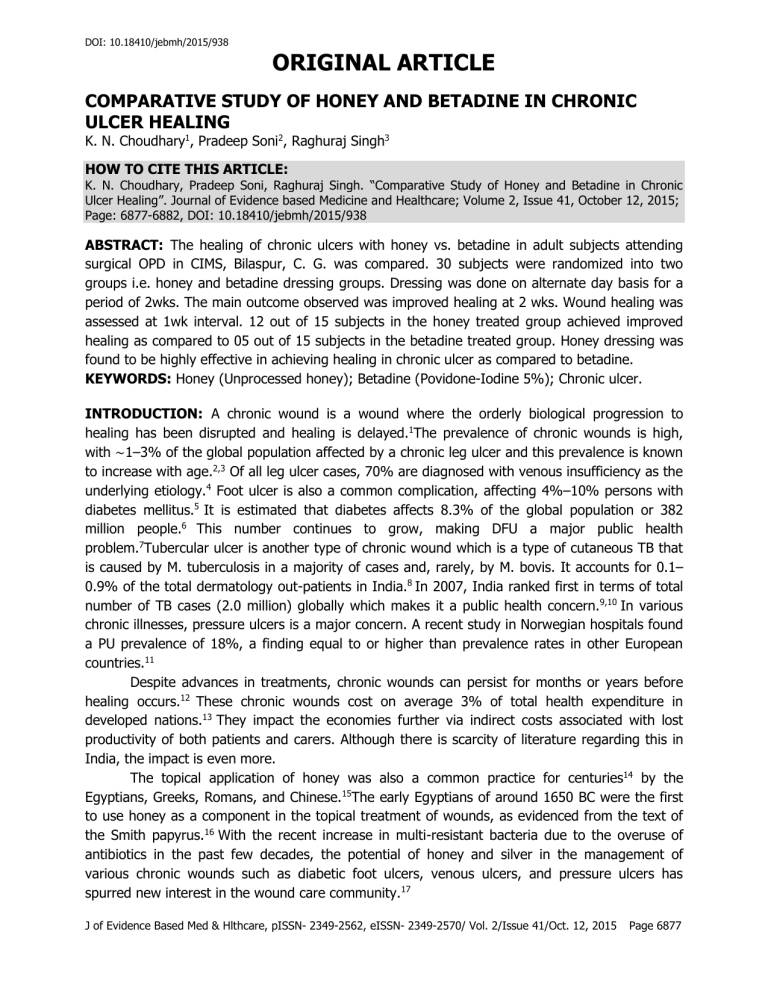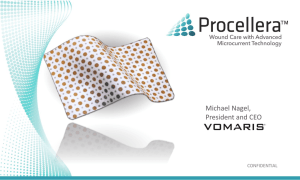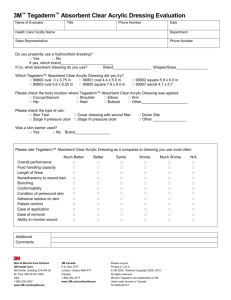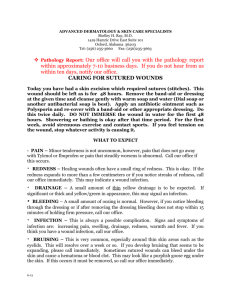comparative study of honey and betadine in chronic ulcer healing

DOI: 10.18410/jebmh/2015/938
ORIGINAL ARTICLE
COMPARATIVE STUDY OF HONEY AND BETADINE IN CHRONIC
ULCER HEALING
K. N. Choudhary 1 , Pradeep Soni 2 , Raghuraj Singh 3
HOW TO CITE THIS ARTICLE:
K. N. Choudhary, Pradeep Soni, Raghuraj Singh.
“Comparative Study of Honey and Betadine in Chronic
Ulcer Healing”. Journal of Evidence based Medicine and Healthcare; Volume 2, Issue 41, October 12, 2015;
Page: 6877-6882, DOI: 10.18410/jebmh/2015/938
ABSTRACT: The healing of chronic ulcers with honey vs. betadine in adult subjects attending surgical OPD in CIMS, Bilaspur, C. G. was compared. 30 subjects were randomized into two groups i.e. honey and betadine dressing groups. Dressing was done on alternate day basis for a period of 2wks. The main outcome observed was improved healing at 2 wks. Wound healing was assessed at 1wk interval. 12 out of 15 subjects in the honey treated group achieved improved healing as compared to 05 out of 15 subjects in the betadine treated group. Honey dressing was found to be highly effective in achieving healing in chronic ulcer as compared to betadine.
KEYWORDS: Honey (Unprocessed honey); Betadine (Povidone-Iodine 5%); Chronic ulcer.
INTRODUCTION: A chronic wound is a wound where the orderly biological progression to healing has been disrupted and healing is delayed.
1 The prevalence of chronic wounds is high, with
∼
1–3% of the global population affected by a chronic leg ulcer and this prevalence is known to increase with age.
2,3 Of all leg ulcer cases, 70% are diagnosed with venous insufficiency as the underlying etiology.
4 Foot ulcer is also a common complication, affecting 4%–10% persons with diabetes mellitus.
5 million people.
6
It is estimated that diabetes affects 8.3% of the global population or 382
This number continues to grow, making DFU a major public health problem.
7 Tubercular ulcer is another type of chronic wound which is a type of cutaneous TB that is caused by M. tuberculosis in a majority of cases and, rarely, by M. bovis. It accounts for 0.1–
0.9% of the total dermatology out-patients in India.
8 In 2007, India ranked first in terms of total number of TB cases (2.0 million) globally which makes it a public health concern.
9,10 In various chronic illnesses, pressure ulcers is a major concern. A recent study in Norwegian hospitals found a PU prevalence of 18%, a finding equal to or higher than prevalence rates in other European countries.
11
Despite advances in treatments, chronic wounds can persist for months or years before healing occurs.
12 These chronic wounds cost on average 3% of total health expenditure in developed nations.
13 They impact the economies further via indirect costs associated with lost productivity of both patients and carers. Although there is scarcity of literature regarding this in
India, the impact is even more.
The topical application of honey was also a common practice for centuries 14 by the
Egyptians, Greeks, Romans, and Chinese.
15 The early Egyptians of around 1650 BC were the first to use honey as a component in the topical treatment of wounds, as evidenced from the text of the Smith papyrus.
16 With the recent increase in multi-resistant bacteria due to the overuse of antibiotics in the past few decades, the potential of honey and silver in the management of various chronic wounds such as diabetic foot ulcers, venous ulcers, and pressure ulcers has spurred new interest in the wound care community.
17
J of Evidence Based Med & Hlthcare, pISSN- 2349-2562, eISSN- 2349-2570/ Vol. 2/Issue 41/Oct. 12, 2015 Page 6877
DOI: 10.18410/jebmh/2015/938
ORIGINAL ARTICLE
Therefore, we have planned to compare the healing of chronic ulcers using honey and betadine dressings and see the efficacy of honey in wound healing.
MATERIAL AND METHODS: The study was conducted in Chhattisgarh Institute of Medical
Sciences, Bilaspur, Chhattisgarh from January 2013 to December 2014 and included patients with chronic ulcers like diabetic ulcers, venous ulcers, pressure ulcers (with slough, contamination, edema and foul smell) and excluded patients with acute wounds like burns, abrasions, lacerations, clean granulated ulcers and patient with antibiotics.
A total of 30 subjects were included in the study after obtaining consent. A detailed history, general physical examination and systemic examination of the subjects were conducted.
The subjects underwent routine blood and urine investigations. They were administered with
Wound Assessment Scale by C William and Wilkins (1997) that assessed size, depth, skin colour, exudate, exudate amount and tissue oedema at the time of admission, 1 st wk and 2 nd wk. All the subjects were given antibiotic coverage, proper nutrition and a hygienic environment. All the patients were subjected to simple occlusive dressing. The subjects were divided into 2 groups –
Group A including 15 subjects who received Honey dressing and Group B including 15 subjects who received Betadine dressing. In this study, honey dressing refers to gauze soaked in 15 to
30ml of unprocessed honey that was applied over the wound once in a day for two weeks and
Betadine dressing refers to gauze was soaked (1:10 dilution) in 15 to 30ml. of antiseptic solution which is applied over the wound once in a day for two weeks.
RESULTS: The present study is a prospective randomised trial which was conducted in
Chhattisgarh Institute of Medical Sciences, Bilaspur, Chhattisgarh from January 2013 to
December 2014. In our study, the age of male subjects was in the range of 21-69 years and female subjects were in the range of 22-68 years. Honey dressing was done in 8 (26.66%) male patients and 7 (23.3%) female patients, whereas betadine dressing was done in 9 (30%) male patients and 6 (20%) female patients.
Sl.
No.
Clinical diagnosis
No. of cases
Honey dressing
Male Female
Betadine dressing
Male Female
1
2
3
4
Diabetic ulcer
Venous ulcer
Pressure ulcer
(bedsore)
9
5
9
3
3
2
2
0
2
2
2
3
2
0
2
Tubercular ulcer
Total
7
30
1
9
2
6
1
8
Mean p value
Table 1: Distribution Of Cases According To The Clinical
Diagnosis In The Group-A And Group-B
3
7
7.44±1.8 8.33±0.94 7.75±1.71 8.14±0.99
0.91 0.41
J of Evidence Based Med & Hlthcare, pISSN- 2349-2562, eISSN- 2349-2570/ Vol. 2/Issue 41/Oct. 12, 2015 Page 6878
DOI: 10.18410/jebmh/2015/938
ORIGINAL ARTICLE
Table 1 shows maximum cases were of diabetic ulcer 9 cases (30%) and pressure ulcer 9 case (30%). The minimum number of cases 5(16.6%) were of venous ulcer.
Diagnosis
Diabetic ulcer
Venous ulcer
Total
No. of cases
6
4
Score at the time of admission
15.8±4.1
18.3±1.5
Score after 1 week of dressing
11.2±2.1
13±1
Score after 2 weeks of dressing
7.4±2.7
7.6±0.5
Net wound healing score after 2 weeks
8.4±4.7
10.6±1.1
Pressure ulcer
(bedsore)
Tubercular ulcer
Total
4
1
15
14.5±3.3
16±1
16±3.09
11±1.6
12±1
11.6±1.6
8.5±3.1
6±1
7.4±2.29
Table 2: Effect of honey on mean wound score
6±5.3
10±0
8.5±3.9
Diagnosis
Diabetic ulcer
Venous ulcer
Pressure ulcer
(bedsore)
Tubercular ulcer
Total
Total
No. of cases
6
3
5
1
Score at the time of admission
15.7±2.0
12.5±2.1
14.4±2.6
17±4.7
Score after 1 week of dressing
13±2.1
11.5±0.7
11.2±1.7
14.25±3.8
Score after 2 weeks of dressing
10.25±4.0
8±2.8
8.4±2.8
10±3.5
Net wound healing score after 2 weeks
5.5±5.1
4.5±4.9
6±3.8
7±4.2
15 15.2±3.2 12.7±2.4 9.2±3.17
Table 3: Effect Of Betadine On Mean Wound Score
5.9±4.0
Table 3 Clinical observation according to wound size, wound depth, exudate type, exudate amount and tissue edema.
Group No. of Cases
Improvement on Wound No Effect
No. % No. %
Honey dressing
Betadine dressing
Mean p value
15
15
12
9
10.5±2.1
0.0001s
80
60
Table 4: A Clinical Observation Of Wound According To
Wound Assessment Scale After 2 Weeks Dressing
3 20
6 40
4.5±2.1
0.045
J of Evidence Based Med & Hlthcare, pISSN- 2349-2562, eISSN- 2349-2570/ Vol. 2/Issue 41/Oct. 12, 2015 Page 6879
DOI: 10.18410/jebmh/2015/938
ORIGINAL ARTICLE
In the study, Group – A subjects showed wound was markedly improved in 12 patients
(80%) who received honey dressing and 3 patients (20%) had no effect on their wound, whereas in the Group – B subjects, wound was markedly improved in 9 patients (60%) who received betadine dressing and 6 patients (40%) had no effect on their wound.
DISCUSSION: Clinicians have used numerous strategies to treat wound infections, including topical and systemic administration of antibiotics and various antiseptic agents like Povidone-
Iodine to kill bacteria or inhibit their growth. Decisions regarding choice of wound treatment involve two basic considerations: (1) how safe is the treatment and (2) how effective is the treatment.
18 Around 1650 BC, Egyptians were the first to use honey as a component in the topical treatment of wounds.
16 Honey is the most ancient wound dressing known, and it has continued to be used throughout the ages.
19 Dioscorides (c.50 AD) wrote of honey being ‘good for sunburn’ and ‘for all rotten and hollow ulcers’, and its usage has continued into present-day folk-medicine.
It is used as a traditional therapy in Ghana for infected leg ulcers.
20 It is still being used as a dressing material for burn wounds, decubitus ulcers, gunshot wounds and wound dehiscence. It enhances auto debridement by absorbing edematous fluid around the ulcer margins and promotes granulation tissue formation and epithelization.
21
This study was conducted over a period of one year and included 30 patients. The age group of patient, sex distribution was almost similar in the both the groups. These patients were divided into two groups, of which the first group (Group-A) dressing of chronic ulcer was done by honey and in the second group (Group-B) dressing of chronic ulcer was done by betadine. In
Group-A, 80% patient (12 cases) showed improvement in their wound, while 20% patient (3 cases) did not have any significant changes in their wound. In Group-B, 60% patients (9 cases) showed improvement of their wound, while 40% patients (3 cases) did not show any significant changes. Thus, honey had significantly better wound healing effect when compared with betadine.
The findings of our study are supported by almost similar results obtained by several other studies in the past, in terms of wound healing and cost effectiveness and less pain while dressing. Shukrimi, 2008 in a single centered, randomized control trial of NIDDM patients with ulcer, comparing non-sterile pure honey (for food) with povidone iodine daily dressing improved the outcome of mean time of surgical closure or further debridement of the wound.
21 Gulati 2014, in a single centre, 2-armed, parallel group RCT, in 45 subjects with chronic wounds of different types like venous ulcer, diabetic ulcer, pressure ulcer, traumatic ulcer compared honey dressing with povidone iodine and film dressing showed complete healing of wounds in 31% subjects in subjects with honey dressing in comparison to none in Povidone Iodine dressing subjects.
22
Marshall 2005, in 51patients with acute surgical wounds after partial or total toe-nail avulsions, found that in the group with honey dressing there was decrease in mean time to healing when compared to the group with povidone iodine dressing daily.
23
In a review by Jull AB et al (2008), there is high quality evidence from two trials that honey dressings heal partial thickness burns more quickly than conventional dressings by around five days and moderate quality evidence from one trial suggesting that honey heals infected postoperative wounds more quickly than povidone iodine washes followed by gauze and is associated
J of Evidence Based Med & Hlthcare, pISSN- 2349-2562, eISSN- 2349-2570/ Vol. 2/Issue 41/Oct. 12, 2015 Page 6880
DOI: 10.18410/jebmh/2015/938
ORIGINAL ARTICLE with fewer adverse events.
15 But further studies needs to be done to arrive at a proper conclusion as to effectiveness of honey as a dressing agent.
CONCLUSION: Although the chronic ulcers that are a consequence of underlying systemic disease is likely to improve with the management of the primary conditions, honey dressing was found to be highly effective in achieving healing in terms of size, depth, skin colour, exudate, exudate amount and tissue oedema, in chronic ulcer as compared to betadine.
Further studies on populations with wounds sharing common etiology, with larger population, with pre-specified outcome measures, random and concealed allocation strategies during assessment can give more conclusive evidence which can be applied to general population.
REFERENCES:
1.
Lazarus GS, Cooper DM, Knighton DR, Margolis DJ, Pecoraro RE, Rodeheaver G, et al.
Definitions and guidelines for assessment of wounds and evaluation of healing. Archives of
Dermatology1994; 130(4): 489–93.
2.
Briggs M. and Closs S.: The prevalence of leg ulceration: a review of the literature. EWMA J
2003; 3: 14.
3.
Margolis DJ., Bilker W., Santanna J., and Baumgarten M.: Venous leg ulcer: incidence and prevalence in the elderly. J Am AcadDermatol 2002; 46: 381. [PubMed]
4.
Abbade LP. andLastória S.: Venous ulcer: epidemiology, physiopathology, diagnosis and treatment. Int J Dermatol 2005; 44: 449. [PubMed]
5.
N. Singh, D. G. Armstrong, and B. A. Lipsky, “Preventing foot ulcers in patients with diabetes,” The Journal of the American Medical Association, vol. 293, no. 2, pp. 217–228,
2005.
6.
International Diabetes Federation, IDF Diabetes Atlas, IDF, 6 th edition, 2013.
7.
E. Tsourdi, A. Barthel, H. Rietzsch, A. Reichel, and S. R. Bornstein, “Current aspects in the pathophysiology and treatment of chronic wounds in diabetes mellitus,” Bio Med Research
International, vol. 2013, Article ID 385641, 6 pages, 2013.
8.
Kumar B, Muralidhar S. Cutaneous tuberculosis: a twenty-year prospective study. Int J
Tuberc Lung Dis 1999; 3: 494-500. Varshney A, Goyal T. Incidence of various clinicomorphological variants of cutaneous tuberculosis and HIV concurrence: a study from the
Indian subcontinent. Ann Saudi Med. 2011 Mar-Apr; 31(2): 134–139.
9.
Global tuberculosis control: Epidemiology, strategy, financing: WHO report 2009. Geneva,
World Health Organization, 2009 (WHO/HTM/TB/2009.411)
10.
TB India 2007; RNTCP status report. New Delhi: Central TB Division, Directorate General of
Health Services, Ministry of Health and Family Welfare, Govt. of India. Central TB
Division. 2007: 10.
11.
Bredesen IM, Bjoro K, Gunningberg L, et al. The prevalence, prevention and multilevel variance of pressure ulcers in Norwegian hospitals: a cross-sectional study. Int J Nurs Stud
2015; 52: 149–56.
J of Evidence Based Med & Hlthcare, pISSN- 2349-2562, eISSN- 2349-2570/ Vol. 2/Issue 41/Oct. 12, 2015 Page 6881
DOI: 10.18410/jebmh/2015/938
ORIGINAL ARTICLE
12.
Ebbeskog B., Skonda E., Lindholm C., Grauers M., and Ohman S.: A follow-up study of leg ulcer patients in south Stockholm. J Wound Care 1999; 8: 170. [PubMed]
13.
Posnett J. and Franks PJ.: The burden of chronic wounds in the UK. Nurs Times 2008; 104:
44. [PubMed]
14.
C. Dunford, R. Cooper, P. Molan, and R. White, “The use of honey in wound management,”
Nursing Standard, vol. 15, no. 11, pp. 63–68, 2000.
15.
A. B. Jull, A. Rodgers, andN.Walker, “Honey as a topical treatment for wounds,” Cochrane
Database of Systematic Reviews, no. 4, Article ID CD005083, 2008.
16.
B. P. Mwipatayi, D. Angel, J. Norrish, M. J. Hamilton, A. Scott, and K. Sieunarine, “The use of honey in chronic leg ulcers: a literature review,” Primary Intention, vol. 12, no. 3, pp.
107–108, 110–112, 2004.
17.
J. L. Sare, “Leg ulcer management with topical medical honey, ”British Journal of
Community Nursing, vol. 13, no. 9, pp.S22–S24, 2008.
18.
Robert IBurks. Povidone-iodine solution in wound treatment. Physther 1998; 78(2): 212-
218.
19.
Zumla A, Lulat A. Honey – a remedy rediscovered. J R Soc Med 1989; 82: 384-5.
20.
Gunther RT. The Greek herbal of Dioscorides. New York: Hafner, 1934. Re- printed 1959.
21.
Shukrimi A, Sulaiman AR, Halim AY, Azril A. A comparative study between honey and povidone iodine as dressing solution for Wagner type II diabetic foot ulcers. Medical Journal of Malaysia 2008; 63(1): 44–6.
22.
Gulati S, Qureshi A, Srivastava A, Kataria K, KumarP, BalakrishnaJi A. A prospective randomized study to compare the effectiveness of honey dressings vs. povidone iodine dressing in chronic wound healing. Indian J Surg 2014; 76(3): 193–198.
23.
Marshall C, Queen J, Manjooran J. Honey vspovidineiodine following toenail surgery.
Wounds UK 2005; 1(1): 10–8.
AUTHORS:
1.
K. N. Choudhary
2.
Pradeep Soni
3.
Raghuraj Singh
PARTICULARS OF CONTRIBUTORS:
1.
Associate Professor, Department of
General Surgery, Chhattisgarh Institute of Medical Sciences, Bilaspur.
2.
Associate Professor, Department of
3.
General Surgery, Chhattisgarh Institute of Medical Sciences, Bilaspur.
Senior Resident, Department of General
Surgery, Chhattisgarh Institute of
Medical Sciences, Bilaspur.
NAME ADDRESS EMAIL ID OF THE
CORRESPONDING AUTHOR:
Dr. K. N. Choudhary,
Associate Professor,
Department of Surgery,
Chhattisgarh Institute of Medical Sciences,
Bilaspur-495001, Chhattisgarh.
E-mail: kn_nutan@yahoo.co.in
Date of Submission: 25/09/2015.
Date of Peer Review: 26/09/2015.
Date of Acceptance: 30/09/2015.
Date of Publishing: 10/06/2015.
J of Evidence Based Med & Hlthcare, pISSN- 2349-2562, eISSN- 2349-2570/ Vol. 2/Issue 41/Oct. 12, 2015 Page 6882








